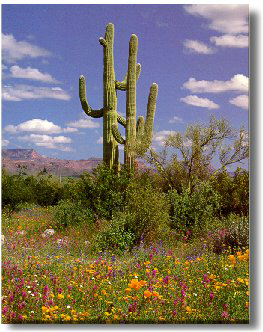

Ribulose bisphosphate (RuBP) can combing with either carbon dioxide or oxygen gas. (a) What determines which of these two gases combines with RuBP? (b) Is there any advantage in having RuBP combine with oxygen rather than with carbon dioxide?
(a) An enzyme, RuBP
carboxylase, catalyzes both the joining of carbon dioxide with RuBP and
the joining of oxygen gas with RuBP. The two molecules are alternative
substrates that compete with each other for the same active site on the
enzyme. The more abundant of the two molecules gets to occupy the active
site and subsequently joins with RuBP. When the concentration of carbon
dioxide in the stroma of the chloroplast is high compared with the concentration
of oxygen, then carbon dioxide joins with RuBP and the Calvin-Benson cycle
is initiated. When the concentration of carbon dioxide is low relative
to oxygen gas, then oxygen joins with RuBP and a pathway known as phororespiration
is initiated. A high concentration of oxygen relative to carbon dioxide
occurs whenever the stomata of a leaf remain closed while photosynthesis
continues. WHY IS THIS SO???????
(b) In photorespiration,
oxygen gas combines with RuBP to form an unstable molecule that breaks
down into glyceraldehyde phosphate and glycolic acid, a two-carbon molecule
that is further catabolized into carbon dioxide. Although this is a form
of respiration, no ATP is produced and much of the energy within RuBP is
lost as heat. Photorespiration has no known BENEFICIAL function and is
detrimental to a cell: RuBP is wasted and glucose production by the Calvin-Benson
cycle is attenuated.
(a) How does the C4 pathway differ from the C3 pathway. of carbon fixation? (b) What are the advantages and disadvantages of each pathway?
(a) The C4 (or Hatch-Slack) pathway differs from the C3 pathway in that carbon dioxide combines first with phosphoenolpyruvic acid (PEP) to form a four-carbon molecule, oxaloacetic acid, whereas in the C3 pathway carbon dioxide combines first with ribulose bisphosphate to form two three-carbon molecules of phosphoglyceric acid In a C4 plant, this initial fixation of carbon takes place in a a mesophylI cell, and the Benson-Calvin cycle occurs in a different kind of cell, called a bundle sheath cell.
The enzyme that catalyzes attachment of carbon
dioxide to PEP in the C4 pathway-PEP carboxylase-has
a strong affinity for carbon dioxide and no affinity for oxygen gas. Thus,
carbon fixation takes place, and the Calvin-Benson
cycle proceeds rapidly even when carbon dioxide concentration is low because
the bundle sheath cells are flooded with carbon dioxide from the mesophyll
cells.
(b) A plant with the C4 pathway has a tremendous
advantage over a plant with a C3 pathway. When the weather is hot,
arid dry, the leaves close their stomata to eliminate water loss. In a
C3 plant this closure results in low carbon dioxide concentrations and,
ultimately, both loss of RuBP and inhibition of the Calvin-Benson cycle
by photorespiration. Is it clear why these two things happen?
There are no such disadvantages in a C4 plant
during hot, dry weather-even with its stomata are closed carbon dioxide
is fixed because of the efficiency of PEP carboxylase in trapping and concentrating
carbon dioxide. Consequently, the Calvin-Benson cycle continues to produce
glucose and there is no loss of chemical energy through photorespiration.
Other than by a detailed biochemical study, how could you distinguish between a C3 and a C4 plant?
There are two distinct kinds of photosythetic cells in a C4 plant: (1) bundle sheath cells which provide the Calvin-Benson cycle and (2) MesophylI cells which provide carbon dioxide fixation through PEP carboxylase. Plants with the C3 pathway, by contrast. have just a single type of photosynthetic cell: the mesophyll cell. Their bundle sheath cells do not contain chloroplasts.
An alternative very
efficient pathway for carbon fixation occurs in the cells of certain
green plants, especially those found in hot, arid climates. The C4 pathway
utilizes a number of four-carbon acids as intermediates. The function of
this pathway is to pick up C02 at low concentrations in the
outer layers of the leaf (the mesophyll) and transport it as a four-carbon
intermediate (such as malic acid) to an inner layer of the leaf (the bundle-sheath
layer). In the inner layer, the four-carbon intermediate breaks down, releasing
the C02 it had picked up in the outer layer. This process delivers
the C02 to the cells where it can be used in the Benson-Calvin
cycle.
Mesophyll has a high concentration
of the enzymes for the C4 pathway and a low concentration of enzymes for
the C3 pathway. Bundle-sheath cells are just the opposite.
The existence of these
two systems makes it possible for those desert plants that have the enzymes
for the C4 system to photosynthesize at a high rate even with the stomata
partially closed, as would happen at rnidday when water loss through evaporation
would be at its highest. You need to be able to explain why this
is true. 
Give some thought to the light-dependent reactions of photosynthesis
and what their basic purpose is and how the plant achieves these goals.
Think about the ways in which a mitochondrium is similar to a chloroplast
both FUNCTIONALLY AND STRUCTURALLY and there important differences.
I am not feeling well and am leaving work. This will have to
do for the second exam.